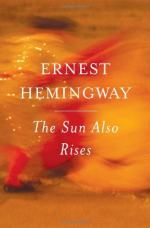|
|
The Sun Also Rises Author/Context
Ernest Hemingway, the second of six children, was born July 21, 1899, in Oak Park Illinois. His parents, Grace Hall Hemingway, a failed singer, and Clarence Hemingway, a doctor, had a troubled marriage. Smart and stubborn, Grace would not conform to the typical role of wife: cooking and cleaning. She liked to fish and hunt, which were uncommon hobbies for a woman. When Clarence Hemingway killed himself in 1928, Ernest blamed his mother.
Alienated from his family, Hemingway left home and in 1917 started writing as a reporter for The Kansas City Star. He was not able to enlist in World War I due to poor sight in one eye, so he became an ambulance driver instead. On one of his first drives to the front lines, Hemingway was injured by enemy fire. After initial surgery he was removed to an Italian hospital, where he fell in love with a nurse, Agnes von Kurowsky. He asked her to marry him, but after he returned to America, she wrote him to say there was another man. The outline of this love story appears in Hemingway's A Farewell to Arms (1929).
After the war Hemingway tried to spend time with his family, but they did not get along. So he left again in 1920 to become a foreign correspondent for the Toronto Star. In 1921 he married Hadley Richardson, and they moved to Paris. Hemingway had met author Sherwood Anderson in Chicago, and Anderson gave Hemingway a letter of introduction to the literary crowd in Paris that included Gertrude Stein, F. Scott Fitzgerald, and Ezra Pound. In 1923 Hemingway published Three Stories and Ten Poems, and in 1925 his story collection, In Our Time was released. Hemingway gained popular and critical success with The Sun Also Rises, published in 1926. His story of wandering and detached expatriates made him the representative for "the lost generation," which Gertrude Stein refers to in the epigraph.
Hemingway eventually married four times. Divorcing Hadley in 1927, he married Pauline Pfeiffer later that year. Another successful novel, A Farewell to Arms, was published two years later, in 1929. Hemingway traveled widely, and lived in Paris, Spain, and Key West, Florida. He split much of his later years between an Idaho ranch, and his home in Cuba, until Fidel Castro overthrewthe government there. Hemingway loved to fish and hunt, going after sailfish in Key West, and hunting big game during his trips to Africa. He continued as a foreign correspondent, covering the Spanish Civil War, which became the basis for his classic novel, For Whom the Bell Tolls (1939).
An alcoholic, Hemingway could be vicious in his opinions, and did not always treat his friends well. He took up boxing in his youth, and he liked to challenge friends to fight and then knock them down. He also used his personal and literary life as fertile ground for his stories and novels. Even his mother received poor treatment as a character in one of his stories. The entire cast of characters of The Sun Also Rises is based on people Hemingway knew. Even though he changed their names, people of the time still understood the references, and Hemingway angered many people with this practice.
Hemingway won the Pulitzer Prize in 1953 for The Old Man and the Sea, his most popular work. He also won the Nobel Prize the following year. Honored for his spare, precise writing style and excellent dialogue, Hemingway greatly influenced the short story and novel forms. His genius was recognized during his life, and his work has become immortal.
Aging, alcoholic, and feeling stuck in a career slump after The Old Man and the Sea, Hemingway killed himself in 1961 at his Idaho home.
Bibliography
deKoster, Katie, ed. "Ernest Hemingway: A Biography" in Readings on Ernest Hemingway. San Diego: Greenhaven Press, 1997.
Hemingway, Ernest. The Sun Also Rises. New York: Collier Books, 1986.
Mellow, James R. Hemingway: A Life Without Consequences. New York: Houghton Mifflin, 1992.
Rovit, Earl, and Gerry Brenner. Ernest Hemingway. Boston: Twayne Publishers, 1986.




